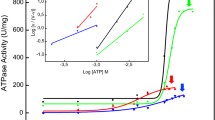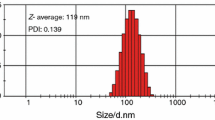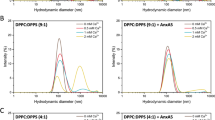Summary
Calcium phosphate precipitation can be induced within liposomes containing buffered inorganic phosphate by the ionophore-mediated loading of calcium ions. Negative staining, positive staining for thin sectioning, and freeze-fracture electron microscopy were used to characterize these synthetic vesicles and to evaluate the liposome-mineral interactions resulting from apatite formation. Suspensions of phosphate (0–50 mM KH2PO4)-encapsulated liposomes were prepared from mixtures of phosphatidylcholine, dicetyl phosphate, and cholesterol in the molar ratios of 7∶2∶1. Precipitation reactions were initiated by first suspending the liposomes in a buffered solution containing calcium (1.3–2.2 mM Ca(NO3)2) and then adding the cationic ionophore X-537 A. All experiments were carried out at 22°C, pH 7.4, and 240 mosm. Transmission electron microscopical analysis showed that the liposome preparation consisted of multilamellar, multicompartmental vesicular structures. The liposomes were typically heterogeneous with respect to both the size and number of phospholipid bilayers surrounding the aqueous cores. In Caloaded liposomes, discrete clusters of apatite mineral were present within the lumen, and in close proximity to the inner lipid membranes. These nascent crystallites eventually penetrated the lipid envelope to provide a focus for external precipitation events. Crystalline apatite phases were not observed when the incubation conditions prevented intraliposomal precipitation. Thede novo calcification of these liposomes had many features in common with the sequence of mineral deposition occurring in matrix vesicle-mediated calcification. These results reinforce the conclusions of earlier chemical and kinetic studies and further support the use of this system as an experimental model for examining the membrane-mineral interactions associated with tissue mineralization.
Similar content being viewed by others
References
Bonucci E (1967) The fine structure of early cartilage calcification. J Ultrastruct Res 20:33–50
Anderson HC (1969) Vesicles associated with calcification in matrix of epiphyseal cartilage. J Cell Biol 41:59–72
Boskey AL (1981) Current concepts of the physiology and biochemistry of calcification. Clin Orthop Rel Res 157:225–258
Anderson HC (1976) Matrix vesicles in cartilage and bone. In: Bourne GE (ed) THe biochemistry and physiology of bone, Vol IV, Academic Press, New York, pp 135–155
Majeska RJ, Wuthier RE (1975) Studies of matrix vesicles isolated from chicken epiphyseal cartilage. Association of pyrophosphatase and ATPase activities with alkaline phosphatase. Biochim Biophys Acta 391:51–60
Fortuna R, Anderson HC, Cartier RP, Sadjera SW (1978) The purification and molecular characterization of alkaline phosphatases from chondrocytes and matrix vesicles of bovine fetal epiphyseal cartilage. Metab Bone Dis Rel Res 1:161–168
Wuthier RE, Gore ST (1977) Partition of inorganic ions and phospholipids in isolated cell membrane and matrix vesicle fractions. Evidence for Ca-phospholipid-PO4 complexes. Calcif Tissue Res 24:163–171
Wuthier RE (1976) Lipids of matrix vesicles. Fed Proc 35:117–121
Eanes ED, Hailer AW, Costa JL (1984) Calcium phosphate formation in aqueous suspensions of multilamellar liposomes. Calcif Tissue Int 36:421–430
Eanes ED, Hailer AW (1985) Liposome-mediated phosphate formation in metastable solutions. Calcif Tissue Int 37:390–394
Eanes ED, Hailer AW (1987) Calcium phosphate precipitation in aqueous suspensions of phosphatidylserine-containing liposomes. Calcif Tissue Int 40:43–48
Vogel JT (1986) Calcium phosphate solid phase induction by dioleoylphosphatidate liposomes. J Coll Interface Sci 11:152–159
Weissmann G, Rita GA (1972) Molecular basis of gouty inflammation: interaction of monosodium urate crystals with lysosomes and liposomes. Nature New Biol 240:167–172
Schumacher HR, Fishbein P, Phelps T, Tse R, Krauser W (1978) Comparison of sodium urate and calcium pyrophosphate crystal phagocytosis by polymorphonuclear leukocytes. Arthritis Rheum 18:783–792
Kane AB, Stanton RP, Raymond EG, Dobson ME, Knafelc ME, Fraber JL (1980) Dissociation of intracellular lysosomal rupture from cell death caused by silica. J Cell Biol 87:643–657
Elferink JGR (1986) Crystal-induced membrane damage: hydroxyapatite crystal-induced hemolysis of erthrocytes. Biochem Med Met Biol 36:25–35
Scott K, Tarin D, Sharp JA (1970) Orientation of spherical specimens for ultrathin sectioning in selected planes by embedding agar. J Microsc 91:216–220
Spurr AR (1969) A low-viscosity epoxy resin embedding medium for electron microscopy. J Ultrastruct Res 26:31–43
Kalina M, Pease DC (1977) The preservation of ultrastructure in saturated phosphatidyl cholines by tannic acid in model systems and type II pneumocytes. J Cell Biol 74:726–741
Thorogood PV, Craig-Gray J (1975) Demineralization of bone matrix: observations from electron microscope and electron-probe analysis. Calcif Tissue Res 19:17–26
Reynolds ES (1963) The use of lead citrate at high pH as an electron-opaque stain in electron microscopy. J Cell Biol 17:208–210
Agostini B, Haselbach W (1971) Effect of some negative stains on the calcium transport of sarcoplasmic reticulum. Histochemie 27:303–309
Raeymakers L, Agostini B, Haselbach W (1981) The formation of intravesicular calcium phosphate deposits in microsomes of smooth muscle. A comparison with sarcoplasmic reticulum of skeletal muscle. Histochemistry 70:139–150
Bonucci E, Ruerink J (1978) The fine structure of decalcified cartilage and bone: a comparison between decalcification procedures performed before and after embedding. Calcif Tissue Res 25:179–190
Zasadzinski JN (1986) Transmission electron microscopy observations of sonication-induced changes in liposome structure. Biophys J 49:119–130
Geyer G (1977) Lipid fixation. Acta Histochem [Suppl] (Jena) S209–222
Landis WJ (1979) A study of the maintenance of calcium and phosphorous in anhydrous preparations of mineralized tissue for electron optical examination. IN: Lechene P, Warner RR (eds) Microbeam analysis in biology. Academic Press, New York, pp 635–651
Saffitz JE, Gross RW, Williamson JR, Sobel BE (1981) Autoradiography of phosphatidylcholine. J Histochem Cytochem 29:371–378
Krueger CM, Nuefield EJ, Saffitz JE (1985) Preservation of arachidonyl phospholipids during tissue processing for electron microscopic autoradiography. J Histochem Cytochem 33:799–802
Zechmeister A (1979) A new selective ultrahistochemical method for the demonstration of calcium using N,N-napthaloylhydroxylamine. Histochemistry 61:223–232
Verkleij AJ, deKruijff B, van Echteld CJ, Noorden PC, Leunissen-Bijvelt J, deGier J (1981) Lipidic particles. Acta Histochem [Suppl] (Jena) S145–149
Fraley R, Wilschut J, Duzgenes N, Smith C, Papahadjopoulos D (1980) Studies on the mechanism of membrane fusion: role of phosphate in promoting calcium ion-induced fusion of phospholipid vesicles. Biochemistry 19:6021–6029
Author information
Authors and Affiliations
Rights and permissions
About this article
Cite this article
Heywood, B.R., Eanes, E.D. An ultrastructural study of calcium phosphate formation in multilamellar liposome suspensions. Calcif Tissue Int 41, 192–201 (1987). https://doi.org/10.1007/BF02555238
Received:
Revised:
Issue Date:
DOI: https://doi.org/10.1007/BF02555238




